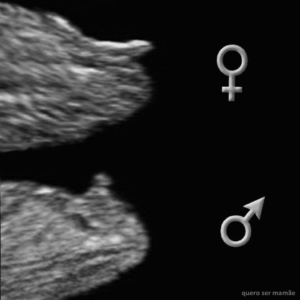A woman’s life is an eternal mystery and anxiety… See, the problem starts when you decide to get pregnant, then it takes a long time and the anxiety is huge. After you finally get pregnant, here comes the baby’s sex! It seems like a never-ending cycle! During my pregnancies, I always had a gut feeling and guessed the baby’s sex by intuition, but waiting for confirmation was still stressful. Most doctors, afraid of making a mistake, only reveal the baby’s sex when they are absolutely certain, and that happens around 16 weeks. And even then, sometimes not!
Fetal Sex Determination
Nowadays, there are lab blood tests that can help ease your anxiety, but they’re not always accessible due to their cost. Fetal sex determination1, for example, is a test that has improved a lot over time, but the price is a bit steep. During my pregnancies, especially the last one, I couldn’t afford to take this test.
IMPORTANT: Errors regarding the baby’s sex are common with ultrasound exams, so wait for the next one to be sure, or choose a second type of test to confirm.
So How Can You Tell the Baby’s Sex?
For those who can’t wait to find out the baby’s sex and want to play detective, I suggest taking a look at the 12-week ultrasound. It can give clues about the baby’s sex and help calm your anxiety. That’s how a friend and I concluded that the baby I was expecting was indeed a girl2.
And if you want to make this moment even more fun, how about starting to research baby names? Usually, couples make preference lists, and with so many suggestions, origins, and meanings, it’s good to start thinking and analyzing to make a good decision once you know the sex for sure.
How to See the Fetal Tubercle?
The fetal genital tubercle is the blueprint for the genitalia3, so to speak. In boys and girls, they are very similar up to the 14th week and doctors can’t be absolutely sure in distinguishing them. However, some in-depth studies indicate that, depending on the inclination angle of the fetal genital tubercle, it is possible to know if the baby is male or female. The images below give an idea of how to determine the baby’s sex just by the angle.


The male genital tubercle has a 30º angle relative to the fetus’ spine, while the female genital tubercle is straight relative to the spine. Simple and very scientific, but to analyze the tubercle’s angle, you have to be lucky with the ultrasound and hope the baby cooperates during the exam. Here’s my 11-week ultrasound. You can clearly see the genital tubercle straight in line with the spine.
I know we moms get anxious and there are other methods to find out the baby’s sex besides the fetal genital tubercle. You could, for example, use more accessible options like the Intelligender urine test for pregnant women.
These methods to determine the baby’s sex help reduce a bit of the couple’s anxiety. However, some people prefer to find out only at birth, but these are very rare cases.
Reader Questions:
Can you tell the baby’s sex by its position?
No, both boys and girls assume the same positions in the uterus and it is not possible to figure out the sex just by the way the baby is positioned.
Besides the fetal tubercle, is there another way to see the sex?
Yes, in addition to analyzing the fetal tubercle and visualizing the genital organ through ultrasound, there are fetal sex determination blood tests that can indicate the baby’s sex with a high degree of accuracy.
Important Tip: If you’ve reached this stage of finding out your baby’s sex, you must be taking folic acid vitamins, right? However, did you know that Methylfolate can help even more in preventing malformations? Yes! That’s because Methylfolate is the active form of folic acid and FamiGesta is the only multivitamin that contains the recommended doses of Methylfolate! You can find FamiGesta here.
Also see: Intelligender and Fetal Sex Determination – Is It Worth Discovering the Baby’s Sex?











